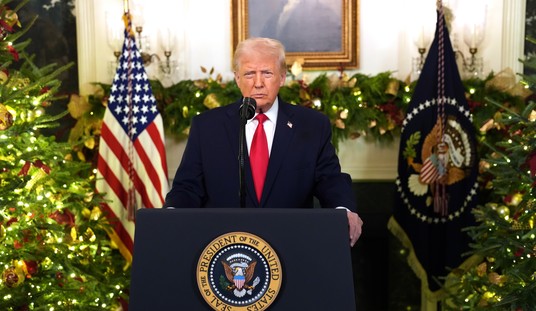A trillion here, a trillion there; pretty soon you’re talking real money. The Washington Post reports:
The Federal Reserve said today that it will deploy an additional $1.2 trillion to try to lower interest rates and stimulate the economy, an aggressive move aimed at containing the recession.
The central bank will increase its purchases of mortgage-backed securities by $750 billion, on top of a previously announced $500 billion. It also will double its purchases of debt in Fannie Mae and Freddie Mac to $200 billion. Those steps are intended to lower mortgage rates. The announcement of the previous purchases pushed mortgage rates down a full percentage point.
Reuters quotes a foreign exchange consultant who mused upon its effect.
“Bottom line is that the Fed is adding $1 trillion to its balance sheet and that’s a lot of taxpayer money,” said Greg Salvaggio, vice president for trading at Tempus Consulting in Washington. “Interest rates now are effectively negative across the board. The dollar is selling off because this may contribute to long-term weakness in the currency. …
However, worsening economic conditions throughout the world mean dollar weakness may not last long, said Robert Blake, senior currency strategist, State Street Global Markets, Boston.”
The Financial Times asks what the Fed will do for an encore. “A landmark day,” said Alan Ruskin, chief international strategist at RBS Greenwich Capital. “This could be cast as a sign of desperation, but confirms that [Fed chairman Ben] Bernanke will do whatever it takes to get some hold of the problem. There is absolutely no point in fighting this move.”
For better or worse, government is now involved to the hilt in economic management. And that’s an intervention that can always cut both ways. The WSJ writes, “Congress Is the Real Systemic Risk “. Any government big enough to give you everything is also big enough to take everything.
After their experience with Fannie Mae and Freddie Mac, you’d think that Congress would no longer be interested in creating companies seen by the market as backed by the government. Yet that is exactly what the relevant congressional committees — the Senate Banking Committee and the House Financial Services Committee — are now considering.
In the wake of the financial crisis, the idea rapidly gaining strength in Washington is to create a systemic risk regulator. The principal sponsor of the plan is Barney Frank, the chair of the House Financial Services Committee. A recent report by the Group of Thirty (a private sector organization of financial regulation specialists), written by a subcommittee headed by Paul Volcker, also endorsed the idea, as has the U.S. Chamber of Commerce and the Securities Industry Financial Markets Association. …
The current financial crisis is certainly systemic. But what caused it? The failure of Lehman Brothers occurred long after the market for mortgage-backed securities (MBS) had shut down, and six months after Bear Stearns had to be rescued because of its losses. In other words, the crisis did not arise from the failure of a particular systemically significant institution. The world’s major financial institutions had already been weakened by the realization that losses on trillions of dollars in MBS were going to be much greater than anyone had imagined, and before the major asset write-downs had begun. So if this was a systemic event, it was not caused by the failure of one or more major institutions. In fact, it was the other way around: The weakness or failure of financial institutions was the result of an external event (losses on trillions of dollars of subprime mortgages embedded in MBS).
If this is true, what is the value of regulating systemically significant financial institutions? Financial failures, it seems, can be the result, rather than the cause, of systemic events like the one we are now experiencing. Even if we assume that regulating systemically significant companies will somehow prevent them from failing — a doubtful proposition, given that the heavily regulated banks have been the most severely affected by the current crisis — we will not have prevented the collapse of a major oil-supplying country, an earthquake or a pandemic from causing a similar problem in the future. All we will have done is given some government agency more power and imposed more costs on financial institutions and consumers.
But nobody’s looking at Barney and other sources of political risk yet. They’re worried about the $126 million in AIG bonuses. That’s chump change. As a noted at the start of this post: a trillion here and a trillion there. Only that is real money these days.
Update: A reader sends these observations from an analyst. The takeaway is that the buy may have been necessary, but not sufficient. There’s more to come.
[The] Fed is now bringing out all the ammo in its arsenal. For someone who looked so calm on 60 Minutes and seemed so convinced that economic recovery was at hand, one would certainly not have expected such a dramatic move by Mr. Bernanke today. It would seem as though the days of incremental “credit easing” moves are now behind us and the Fed is now bringing out all the ammo in its arsenal. …
So, as the Fed’s balance sheet now expands to represent nearly 25% of GDP, we no longer have to ask the question as to whether or not we are just like Japan, for that is what the BoJ balance sheet looked like after the central bank embarked on its quantitative easing program nearly a decade ago. …
Government cannot prevent nature from taking its course. While an additional $1.15 trillion expansion of the Fed’s balance sheet is large as a stand-alone event, it really is just a drop in the bucket when one considers that there is still almost $8 trillion of combined household and business sector credit that must be unwound in order to mean-revert the private sector-to-GDP ratio (which is still close to a record-high). Once again, the government is cushioning the blow, but cannot prevent nature from taking its course, in our view.
The Three Stooges demonstrate how the cure can be not much better than the disease.
[youtube k3s8sEYzHWQ]










Join the conversation as a VIP Member